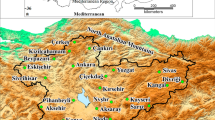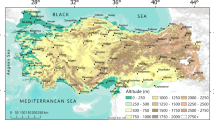Summary
Spatial and temporal patterns of trends in the diurnal temperature ranges (DTRs) of the 70 stations and the role of maximum and minimum temperatures on the year-to-year variability and the long-term trends of the DTRs in Turkey have been investigated for the period 1929–1999. The principal results of the study are as follows:
(i) The daytime maximum temperatures have shown weak warming and cooling in comparison with significant warming of the night-time minimum temperatures in many regions of Turkey and in most seasons. (ii) The DTRs have significantly decreased at most of the urbanised and rapidly urbanising stations throughout the seasons except partly in winter, without showing an apparent north/south (west–east) and land/sea gradient. (iii) Annual and seasonal DTRs of some stations have shown significant increasing trends. Nevertheless, the spatial distribution of significant increasing trends in the DTR series is geographically incoherent across the country in all seasons and annually, as compared with significantly decreased DTRs. (iv) Autumn and summer DTRs have decreased generally at a higher rate than in winter and spring. (v) Changes in the temperature regime of Turkey towards the more temperate and/or warmer climate conditions are most strongly related with the significant night-time warming in spring and summer. (vi) Magnitudes and signs of correlation coefficients and correlation patterns between the DTRs and the maximum and minimum temperatures have revealed that there is an opposite physical control mechanism on the year-to-year variability and the long-term variations and trends in the DTRs, particularly for the annual, spring and summer series. (vii) Significant increases of the night-time temperatures have most likely led to strong decreasing trends in the DTRs of most stations during the spring and summer seasons and annually and of some stations during winter and autumn. (viii) The asymmetric trends and the symmetric, but with different magnitude, trends in the maximum and minimum temperatures resulted in a significant decrease in the DTRs of many stations and are a considerable signal of ongoing changes in the climatic variability of Turkey.
Similar content being viewed by others
Author information
Authors and Affiliations
Rights and permissions
About this article
Cite this article
Türkeş, M., Sümer, U. Spatial and temporal patterns of trends and variability in diurnal temperature ranges of Turkey. Theor Appl Climatol 77, 195–227 (2004). https://doi.org/10.1007/s00704-003-0024-5
Received:
Revised:
Accepted:
Published:
Issue Date:
DOI: https://doi.org/10.1007/s00704-003-0024-5




